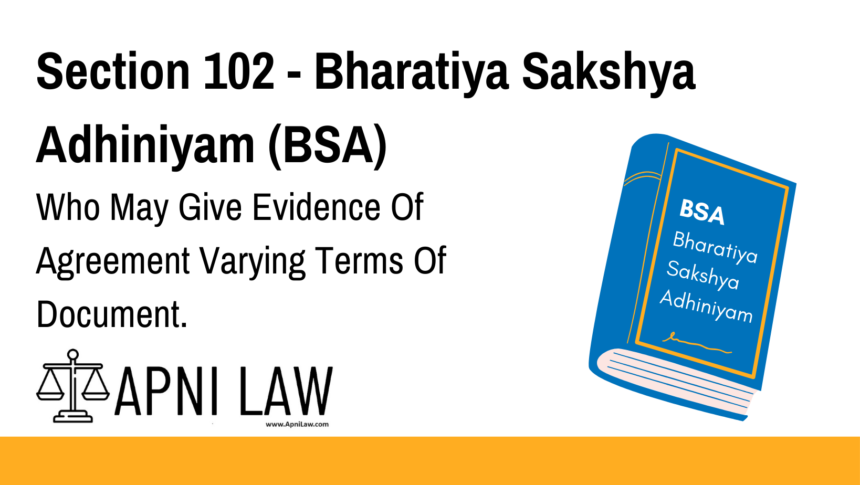Code: Section 102 Bharatiya Sakshya Adhiniyam, 2023
Persons who are not parties to a document, or their representatives in interest,
may give evidence of any facts tending to show a contemporaneous agreement varying the
terms of the document.
Illustration.
A and B make a contract in writing that B shall sell A certain cotton, to be paid for on
delivery. At the same time, they make an oral agreement that three months’ credit shall be
given to A. This could not be shown as between A and B, but it might be shown by C, if it
affected his interests.
Explanation of Section 102 BSA
Section 102 of the Bharatiya Sakshya Adhiniyam (BSA), 2023 deals with the admissibility of evidence regarding agreements that vary or modify the terms of a written document. Specifically, it clarifies that:
- Persons who are not parties to the document (third parties), or their representatives in interest,
- May provide evidence of an agreement made at the same time as the document (a contemporaneous agreement),
- That modifies or alters the terms of the original written document.
While the primary parties to a written contract are typically bound by the terms of that document and cannot introduce oral agreements to alter it (per Section 100 BSA), this section creates an exception for third parties.
It allows third parties to present such evidence when it is relevant to their own rights or interests.
Key Takeaways:
- Only non-parties to the contract can use this section.
- The oral agreement must be contemporaneous with the written document.
- Evidence is admissible only if it affects the third party’s rights or interests.
Illustration
A and B enter into a written contract stating that B will sell cotton to A, to be paid for upon delivery.
However, at the same time, A and B make an oral agreement that A will have three months to pay.
Now, if there is a dispute between A and B, this oral agreement cannot be used to contradict the written terms (payment on delivery).
However, if C, a third party, is affected by this agreement—for instance, if C is a creditor of A or a party who acquired rights based on the expected timing of the payment—C may give evidence of this oral agreement to protect their own interests.
Common Questions and Answers on Section 102 BSA
- Who can use Section 102 to present evidence?
- Only persons who are not parties to the original document or their legal representatives in interest.
- What kind of agreement can be introduced?
- A contemporaneous oral agreement that varies or supplements the terms of the written document.
- Can the original parties (e.g., A and B in the example) use this section?
- No. This section does not allow original parties to vary written terms using oral agreements.
- Why is this exception allowed for third parties?
- To ensure that third parties are not unfairly affected by private arrangements that were not disclosed in the written document but materially impact their rights or interests.
- How is this different from Section 100 of BSA?
- Section 100 prohibits parties from varying written contracts with oral agreements. Section 102 creates a limited exception for third parties when their rights are at stake.
Conclusion
Section 102 of the Bharatiya Sakshya Adhiniyam, 2023 recognizes that third parties should not be bound by the same evidentiary rules as the original contracting parties. It protects their rights by allowing them to introduce evidence of oral or contemporaneous agreements that affect their interests—even if such evidence would be inadmissible between the original parties.
This section upholds transparency and fairness in situations where undisclosed agreements might otherwise prejudice someone who was not directly involved in the contract.
For more simplified legal explanations and expert commentary, visit ApniLaw.











